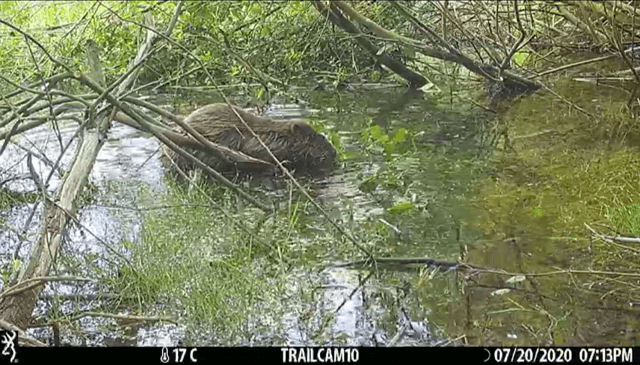


In March, on the cusp of lockdown, we released two beavers into an enclosure at Wild Ken Hill. Below, we describe how the beavers have been getting on, and why this continues to be an incredibly important part of our project.
As those who followed our beaver re-introduction will know, both beavers were from wild populations in Tayside. Since the re-introduction, it was revealed that 20% of the wild Scottish beaver population (87 beavers) were killed under license in just 7 months in 2019. We think this is shocking given this animal nominally holds protected status in Scotland.
We are particularly glad that we chose to translocate animals from Scotland to Wild Ken Hill rather than releasing animals bred in captivity – these animals need protection not prosecution and we are glad to provide it.
Back at Wild Ken Hill, deploying 10 camera traps in the enclosure since the release has enabled us to get a decent understanding of the animals’ behaviour. One (Ebb) has found a large pond where she seems to be very comfortable feeding on the willow; the other (Flow) has plugged some old culverts to create a long linear wetland system toward the north of the enclosure.

There is more water than historically in parts of the site, and camera trap footage has shown interesting species use of the area: we have seen goshawk bathing in the ponds and an otter spend over a week in the area for the first time in decades.
Although these are promising early signs, there is still huge scope for our beavers to change the ecosystems within the enclosure. Shortly after the reintroduction of the beavers, we experienced an incredibly dry period of weather, with little to no rain across the catchment that drains into our beaver enclosure for around 2 months.

Loosely speaking, beaver damming activity is reactive to the rate of flowing water (they respond to the sound of flowing water!). We think the suppressed water flow rates since the beavers’ arrival has resulted in our beavers doing a bit less damming than typical. Given the existing ponds within the enclosure, and fantastic access to foodstuff, there has probably been less environmental pressure on the beavers to dam and flood areas.
We also wonder whether the absence of males in the enclosure has impacted the behaviour of the animals. For example, we haven’t observed any lodge-building behaviour so far, perhaps this will happen when the beavers are in pairs and breeding?

The good news is that two males are due to join our females very shortly. Both are due to also be sourced from wild populations in Scotland. These males will be trapped under the Scottish Natural Heritage Beaver Mitigation scheme by Roisin Campbell-Palmer, before being transferred to Five Sisters Zoo for full health screening according to DEFRA recommendations. We expect them to pair up with the two females, and hopefully breed in the coming season. With greater numbers of beavers in the enclosure, and with winter to come, we’re expecting there to be plenty more damming and lodge-building activity.
While the beavers go about re-wetting this area of woodland, the broader rewilding project continues to evolve. The post-agricultural fields were a bright mess of plants this year, our initial work in the woodland is kickstarting natural processes, and we have wild cattle and pigs due to be introduced in September – overall, it’s wonderful to see beavers thriving as part of wider landscape-scale restoration.

A number of beavers have now been successfully relocated to restoration projects in England so we are incredibly proud to support this process and be a vital part in promoting the restoration of this lost native mammal, with all the biodiversity benefits they bring.
We will keep you updated on the plans to bring two males down from Scotland, and how the beavers’ impact evolves. For more frequent updates, you can follow us across our social media channels!